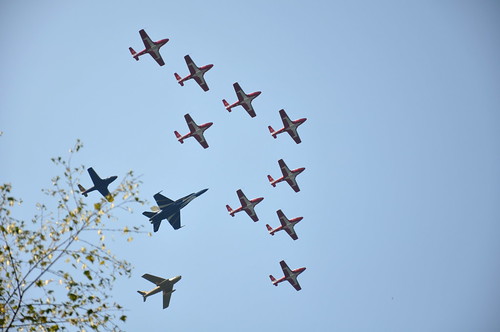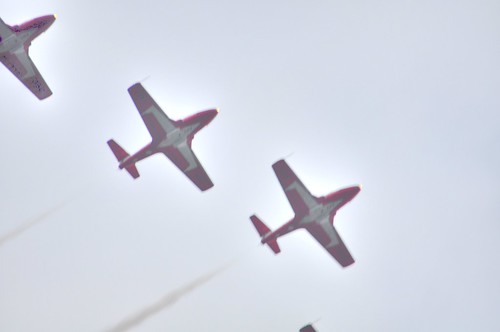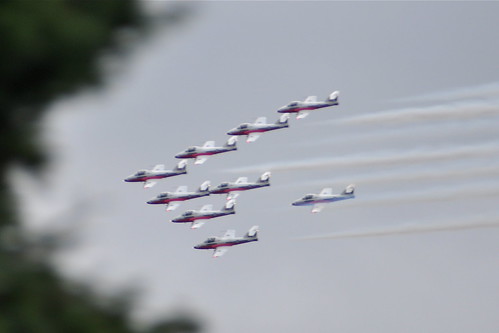Penmachine
26 April 2010
Two more arguments for learning statistics
One of my repeated themes here over the years is how genuinely lousy the human brain is at intuitively understanding probability and statistics. Two articles this week had me thinking about it again.
The first was Clive Thompson's latest opinion piece in Wired, "Why We Should Learn the Language of Data," where he argues for significantly more education about stats and probability in school, and in general, because:
If you don't understand statistics, you don't know what's going on—and you can't tell when you're being lied to.
Climate change? The changing state of the economy? Vaccination? Political polls? Gambling? Disease? Making decisions about any of them requires some understanding of how likelihoods and big groups of numbers interact in the world. "Statistics," Thompson writes, "is the new grammar."
The second article explains a key example. At the NPR Planet Money blog (incidentally, the Planet Money podcast is endlessly fascinating, the only one clever enough to get me interested in listening to business stories several times a week), Jacob Goldstein describes why people place bad bets on horse races.
After exhaustive statistical analyses (alas, this stuff isn't easy), economists Erik Snowberg and Justin Wolfers have figured out that even regular bettors at the track simply misperceive how bad their bets are, especially when wagering on long shots—those outcomes that are particularly unlikely, but pay off big if you win, because:
...people overestimate the probability of very rare events. "We're dreadful at perceiving the difference between a tiny probability and a small probability."
In our heads, extremely unlikely things (being in a commercial jet crash, for instance) seem just as probable, or even more probable, than simply somewhat unlikely things (being in a car crash on the way to the airport). That has us make funny decisions. For instance, on occasion couples (parents of young children, perhaps) choose to fly on separate planes so that, in the rare event that a plane crashes, one of them survives. But they both take the same car to the airport—as well as during much of the rest of their lives—which is far, far more likely to kill them both. (Though still not all that likely.)
Unfortunately, so much of probability is counterintuitive that I'm not sure how well we can educate ourselves about it for regular day-to-day decision-making. Even bringing along our iPhones, I don't think we should be using them to make statistical calculations before every outing or every meal. Besides, we could be so distracted by the little screens that we step out into traffic without noticing.
Our minds are required be good at filtering out irrelevancies, so we're not overwhelmed by everything going on around us. But the modern world has changed what's relevant, both to our daily lives and to our long-term interests. The same big brains that helped us make it that way now oblige us to think more carefully about what we do, and why we do it.
Labels: airport, games, magazines, podcast, probability, psychology, radio, transportation
04 November 2009
Family and flight
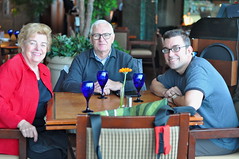 Today my parents flew to Frankfurt for a couple of weeks in Germany. They're staying with friends in Bad Zwischenahn, as well as visiting some of my father's relatives in Berlin, where he was born and lived until 1955. They had enough airline points to travel First Class, which I don't think they've ever done before.
Today my parents flew to Frankfurt for a couple of weeks in Germany. They're staying with friends in Bad Zwischenahn, as well as visiting some of my father's relatives in Berlin, where he was born and lived until 1955. They had enough airline points to travel First Class, which I don't think they've ever done before.
Their trip is shorter than they had initially planned. My parents live next door to us in our duplex, the same house where I grew up, and they offer us a lot of support, especially with the kids, and particularly since I've been ill over the past few years. I told them a few weeks ago that their initial trip seemed too long to me. It was hard to admit that—I'm 40 years old and don't like having to depend on my parents again.
Yet it wouldn't have been fair not to ask. I have a lot of side effects from the cancer medications these days, and while we can handle not having my mom and dad nearby for a week or two, longer than that is likely to put a lot of pressure on my wife, and my daughters, when I'm not feeling well.
The three of us, Mom, Dad, and I, drove to the airport today, and had a fancy lunch in the Fairmont Hotel overlooking the jetway. I dropped them at the gate, then walked around the airport a bit and watched the planes some more. Then I drove home and spent an hour in the bathroom, as happens these days.
I'm sure they'll have a fun trip, and I'm glad they could go. I'll be happy to pick them up when they return too.
Labels: airport, cancer, europe, family, travel
09 August 2009
Snowbirds overhead
This weekend in Vancouver included the Abbotsford Airshow, the Burnaby Blues and Roots Festival, the Under the Volcano festival, and the closing ceremonies of the World Police and Fire Games (WPFG). Twice over the past few days, I've seen the Canadian Forces Snowbirds aerobatics team fly directly over my head in conjunction with some of those events. Once in Stanley Park (presumably to promote the Airshow):
And once this evening right in our front yard, when the Snowbirds flew right over our house (on the last of four passes). At first I thought it was for the Blues Fest, but I think it was really for the WPFG finale:
Both times, I could almost read the markings on the bottoms of the planes. It still amazes me that human beings, we apes from the savannah, can control flying machines traveling at hundreds of kilometres an hour in formation:
Such brains we humans have.
Labels: airport, music, photography, sports, transportation
19 May 2009
Airliners are modern miracles of science and engineering
 We've just returned from a whirlwind trip. My daughters had an extra day off school, a professional day following the Victoria Day long weekend, so we made quick plans to stay in a hotel in the Seattle suburb of Lynnwood, Washington, a couple of hours' drive south of here. But to thread the needle of long weekend border traffic, we crossed our station wagon into the USA on Sunday and returned Tuesday.
We've just returned from a whirlwind trip. My daughters had an extra day off school, a professional day following the Victoria Day long weekend, so we made quick plans to stay in a hotel in the Seattle suburb of Lynnwood, Washington, a couple of hours' drive south of here. But to thread the needle of long weekend border traffic, we crossed our station wagon into the USA on Sunday and returned Tuesday.
I'm not quite sure how we fit all we did into the 54 hours we were away, but it included a number of family firsts. My older daughter is a big fan of shrimp, and has been enticed by endless ads for the Red Lobster chain of restaurants. We have none in Vancouver, so Lynnwood offered the closest location, and despite lingering memories of a 1995 food poisoning incident at a California location on our honeymoon, my wife and I agreed to go. We all enjoyed our meals there Sunday night, without later illness.
That was the least of the newness, though. My wife Air and I have traveled to Greater Seattle many times over the years, separately during our childhoods and together since we started dating, both with our kids and without, for fun and on business, as a destination and on the way elsewhere. Yet somehow neither of us had ever visited the wonderful Woodland Park Zoo, or Lynnwood's famous Olympus Spa, or Boeing's widebody jet factory in Everett. This trip we covered them all: the kids and I hit the zoo, Air visited the spa, and all four of us took the Boeing tour today on the way home.
The zoo impressed me, especially the habitats for the elephants, gorillas, and orangutans, but while it was a much shorter activity, the Boeing tour was something else. If you live in this part of the world (Vancouver, Seattle, Portland, and environs), and you're a geek who likes any sort of complicated technology, or air travel, or simply huge-ass stuff, you must go, especially considering there's nowhere else in the world you can easily see something similar. The Airbus factory in France requires pre-registration months in advance, with all sorts of forms filled out and approvals and so forth. We just drove up to Everett, paid a few bucks each, and half an hour later were on our way in.
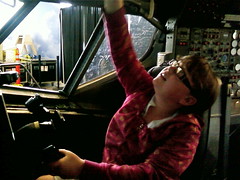 Unfortunately, you're prohibited from taking cameras, electronics, food, or even any sort of bag or purse beyond the Future of Flight exhibit hall where the tour begins, so I have no photos of the assembly plant itself. Trust me, though, it is an extraordinary place. A tour bus drove our group the short distance to the structure, which is the most voluminous building in the world. (Our guide told us all of Disneyland would fit inside, with room for parking. Since the plant is over 3,000 feet long, I figured out that the Burj Dubai tower, the world's tallest building, could also lay down comfortably on the factory's floor space.)
Unfortunately, you're prohibited from taking cameras, electronics, food, or even any sort of bag or purse beyond the Future of Flight exhibit hall where the tour begins, so I have no photos of the assembly plant itself. Trust me, though, it is an extraordinary place. A tour bus drove our group the short distance to the structure, which is the most voluminous building in the world. (Our guide told us all of Disneyland would fit inside, with room for parking. Since the plant is over 3,000 feet long, I figured out that the Burj Dubai tower, the world's tallest building, could also lay down comfortably on the factory's floor space.)
From two separate third-level vantage points inside, accessed by walking down immensely long underground tunnels, then taking freight elevators up into the factory's rafters, we saw more than a dozen of the world's largest aircraft in various stages of assembly. They included several units of the venerable and massive Boeing 747 (its still-revolutionary design is older than me); a couple of nearly complete 767s; a string of 777s in their slow-crawling, constantly-moving U-shaped assembly line; and finally a trio of 787s—a design so new that they are built mostly of composite materials instead of metal, and not even one has yet entered commercial service.
The end of the tour took us outside again on the bus, past the painting hangars and numerous planes waiting for pickup by airlines, as well as one of Boeing's three Dreamlifter cargo monsters, created by cutting off most of the upper half of an old 747 and installing a huge new fuselage top, purely to bring in assembled parts for the new 787s, to be fitted together inside the factory.
While that facility is one structure, which has been expanded over time, each type of plane built there demonstrates how aircraft construction, and industrial assembly lines in general, have changed in the past 40 years. 747s are still built at numerous discrete stations, as they were when the Everett plant first opened in the 1960s. As I mentioned, 777s come together in a single, steady-moving U-shaped line, apparently inspired by the envied Toyota Production System, each plane edging forward steadily at 1.6 inches per hour.
Finally, the new 787 comes together in a short, simple line across the width of the building. That's because (as with competitor Airbus's planes) sections of each aircraft arrive nearly complete from other factories around the world on the Dreamlifter cargo carriers, and are put together in Everett, rather than built from scratch.
I came away newly inspired by the modern miracle of science and engineering that is a jet airliner. These machines are what enable us to complain about waiting around in airports for a few hours, and about substandard in-flight food as we fly between continents—while forgetting that not many lifetimes ago, and for all of human history beforehand, similar voyages might take have taken us years instead of hours, facing danger and starvation and death, if they were possible at all.
Then, on the way home, we bought a bunch of squeeze cheese, also unavailable here in Canada.
Labels: airport, americas, animals, family, geekery, science, seattle, transportation, travel
15 February 2009
How to make a pleasant airport
Salon's Patrick Smith, pilot and aviation writer, has a great list of 15 things all airports should have, created in consultation with his readers:
- A fast, efficient, low-cost public transportation link to downtown
- Complimentary wireless Internet
- Power ports
- Convenience stores ("What's with all the luggage stores? Who the hell buys luggage after they get to the airport?")
- Showers and a short-stay hotel
- Play area for children
- ATMs
- An information kiosk
- A place to send mail and buy postage
- A bookstore
- Ample gate-side seating: at least as many chairs as there are seats on the plane!
- A quiet area
- Art and greenery
- Double-wide escalators
- Windows with a view of the planes
Vancouver's airport is pretty good (the transit is coming this year, there's a good play area, and you can see the planes in several places), but in general we do a crappy job of these in North America.
If you're killing time at YVR, I strongly recommend a (slightly pricey) meal or drink in the lounge of the attached Fairmont Hotel. It's quiet, comfortable, the food is good, and you can both watch the aircraft and enjoy a nice view of our mountains. We try to go there anytime we're flying, or even dropping off or picking up family and friends.
Labels: airport, americas, transportation, vancouver
06 July 2008
Coming back home
 On Tuesday, my wife Air and our two daughters were joined by our friends KA and her son to fly to Disneyland, where they have been (with, for the first couple of days, our Australian friend Leesa, bound for home in Melbourne) for almost a week now. They fly home late tonight, when I'll pick them up at the airport.
On Tuesday, my wife Air and our two daughters were joined by our friends KA and her son to fly to Disneyland, where they have been (with, for the first couple of days, our Australian friend Leesa, bound for home in Melbourne) for almost a week now. They fly home late tonight, when I'll pick them up at the airport.
As you might expect, it's one of those vacations that requires a nice break afterwards: they've been going going going almost non-stop for five days, with a few opportunities to sleep, swim in the pool, and have breakfast at the Best Western. To avoid the monster crowds on U.S. Independence Day on July 4, they rented a car for the 25-mile drive to Laguna Beach for a day in the surf, followed by In-N-Out Burger (mmm, In-N-Out).
The week has certainly felt odd here. I had a significant to-do list, including some paperwork, but (as I should have expected) only got about half of it done. What's most remarkable is how quiet our house is, and how little I've had to do laundry or run the dishwasher.
It's a bit lonely, however, and while I have as much room as I want to sprawl out in bed and sleep in, I've found myself still lying on my side next my wife's empty pillow, and not for as long hours as I might have thought. (I have returned to my college-age nocturnal behaviour, though, often staying up till 2:00 a.m. or later.) I'll be glad to have everyone back soon, so we can start our family summer, which I hope is a good one.
Labels: airport, family, food, travel
01 July 2008
Happy Canada Day
It was a long, enjoyable Canada Day for me, even though it included a 3 a.m. wakeup to take my wife and kids to the airport for a trip to Disneyland, another trip a few hours later for our friend Leesa to fly towards home, and, later, nightmarish traffic to Vancouver's North Shore for a barbecue:
Labels: airport, friends, holiday, photography, travel, vancouver
30 June 2008
Today I am 39 for the first time
I don't think I'll become one of those reluctant to reveal his age. Hell, I'm damn proud of each further year I get at this point. So today I turn 39, for the first and last and only time. It will be a hectic day, with much packing and running around.
Why? Because tomorrow, Canada Day, July 1, my wife and daughters leave for a week at Disneyland, and I'm taking them, with our friend KA and her son, to the airport at 4:00 a.m. (!) for their 6:30 flight. A few hours later, I'll be back at the airport to drop off our friend Leesa for her return to Australia.
Then, as I begin a few days of solo living bachelor style, I have a couple of Canada Day parties I may attend, and maybe even a show by the Adam Woodall Band in the evening. That is, if I'm not so exhausted from the early wake-up that I just sleep away the rest of our national day.
So I won't reflect too much on my birthday. You can, however, read what I wrote at the end of June in 2007, 2006, 2005, 2004, 2003, 2002, and 2001.
My my. I have been at this blogging thing for awhile now.
And here, for no reason other than that I like it, is a picture of my daughters coming home from the last day of school:
It's summer, baby!
Labels: airport, birthday, family, holiday, travel
16 May 2008
Overhead
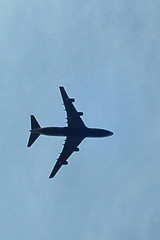 I've just come from sitting in the yard, reading, for more than an hour, with the kids passing around a volleyball and swinging on the swings. This long Victoria Day holiday weekend, Vancouver is having an early heat-wave blast of summer, with temperatures reaching 30° C here in the suburbs, so we're taking advantage of it. It certainly feels—if only temporarily—like a full summer day, since the sun set around 8 p.m., the same time it will in July.
I've just come from sitting in the yard, reading, for more than an hour, with the kids passing around a volleyball and swinging on the swings. This long Victoria Day holiday weekend, Vancouver is having an early heat-wave blast of summer, with temperatures reaching 30° C here in the suburbs, so we're taking advantage of it. It certainly feels—if only temporarily—like a full summer day, since the sun set around 8 p.m., the same time it will in July.
When the wind is westerly, as it is today, airplanes coming in from the Pacific to Vancouver Airport fly a slow U shape, east across the city, turning south, and then coming in to land flying westward over Richmond to the south. This evening, several massive 747s went almost directly over our house in Burnaby, as they often do, high enough not to be disturbing but low enough that we can read their tail insignia, then watch them bank slightly and make their wide turns over the suburbs further east.
Jumbo jets, like all aircraft, continue to astound me, and it's a pity so many of us spend most of our time complaining when we talk about air travel. Journeys that used to take weeks or months now take hours. They have changed the world, and I get to watch them begin and end in the sky over my house every day.
Labels: airport, travel, vancouver, weather
12 May 2008
What makes a nice airport?
"Situation Terminal" (via Philip Greenspun) laments the generally lousy state of modern airport design. Author Paul Goldberger writes that:
Airports are essentially machines for processing people, airplanes, automobiles, cargo, and luggage—all of which move in different ways, and which need to be connected at certain points and separated by rigid security at others.
The problem, he notes, is that in most current facilities are:
....an efficient layout for airport operations, as long as you don't consider passenger pleasure to be a part of airport operations.
I don't have a lot of experience with airports around the world—I've never been to the new terminals in China and Europe that Goldberger profiles as rare successful airport architecture—but I think Vancouver's YVR does a surprisingly decent job of it.
While many Vancouverites continue to complain about the "Airport Improvement Fee," instituted in the early '90s when the Canadian government leased the facility to the Vancouver Airport Authority, the money from that fee has transformed what was a small, drab, concrete slab during my childhood into a much larger, more interesting, well-lit, and beautiful space.
One thing I do find puzzling at YVR: most of the huge collection of Northwest Coast native art is well displayed, but it's in the international arrivals area. That's the one part of the facility where people are moving as fast as they can to get off their planes, through Customs, and out—where they'll spend little to no time looking at the artwork. There's a lot less of that stuff in the departure areas, which is where passengers are sometimes waiting around for hours, and where they might find some use looking at the art. Weird.
07 April 2008
Lovely aerial night city photos from Doc Searls
Check out this beautiful set of pictures of city lights from Doc Searls. He took them while flying on a commercial jet up the U.S. East Coast:
It's a shame that we waste so much energy radiating light out into space, but it's pretty.
Labels: airport, art, canon, docsearls, environment, flickr, photography
